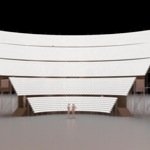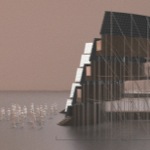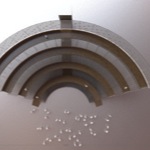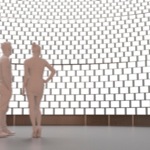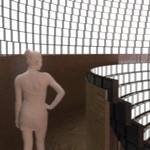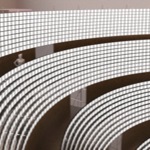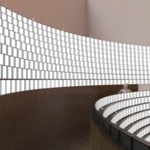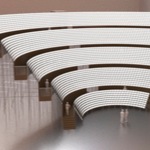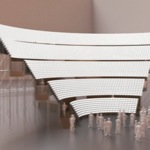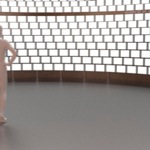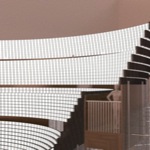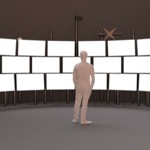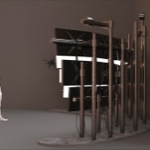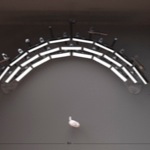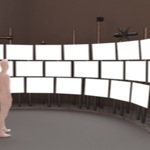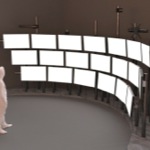Population Theatre
"Population Theatre" is a scalable data-visualization theatre consisting of 7.5 billion individual computer-controlled points of light. The purpose of the piece is to create an experience that offers a one-to-one relationship between the world’s population and its data: every person alive is represented by a single point of light.
"Population Theatre" is a stepped semi-circular structure, —similar to Vitruvian Theatres that inspired the ancient Memory Theatres—, designed parametrically. Concentric levels hold exactly 3,617 HD flat screen monitors, each 15 inches in diagonal, facing the centre of the stage. The public standing on the central stage have a line of sight to all 7.5 billion points of light, like a Panopticon. They can also walk along corridors at different rows of the theatre to see data points up close and look out into the stage. The complete structure is 35 m wide, 25 m deep and 14 m tall, but it can be expanded adding rows of monitors as the World’s population grows. The central stage has a diameter of 10 metres and can hold about 50 people simultaneously with a perfect view and an additional 100-200 with a partial view; in addition, the corridors can hold another 50 people. An elevator behind the theatre allows wheelchair access to any row.
Each monitor in "Population Theatre" provides over 2 million pixels, creating a staggering 7.5-billion-pixel screen. This is 26 times more resolution than the UC San Diego scientific display system, the World’s highest resolution display, with 287 million pixels. Key to accomplishing this technological feat is the use of new, inexpensive Raspberry Pi Zero computers. These tiny computers cost US$5, have built-in HD video output and will be expanded with a board for wireless networking.
The project is not meant as a coherent display of imagery but for each pixel to operate according to data for a single individual on the planet. For this reason, the word "pixel", short for "picture element", is not appropriate as the piece is not attempting to create coherent panoramic images. A new word to describe a point of light in this system is a "perxon", where each perxon is just a "per capita" data point, not a representation based on proximity to other pixels in a screen array.
The project is inspired by Buckminster Fuller’s "World Game", which was a proposed platform for global networked data-visualization in the 1960s. Fuller’s idea called for a "systems approach where the entire world is now the relevant unit of analysis, not the city, state or nation". We are, in Fuller's words, "onboard Spaceship Earth." In order to have this kind of power, the game needed a comprehensive database that would provide the players with better data than their politically elected or appointed counterparts. Players needed an inventory of the world's vital statistics—where everything was and in what quantities and qualities, from minerals to manufactured goods and services, to humans and their unmet needs as well as capabilities. They also needed an information source that monitored the current state of the world, bringing vital news into the "game room" live. All of this "big data" that Fuller imagined is now attainable thanks to the Internet, a metrics-based society, new simulation tools, global surveillance, and scalable computer power of the cloud and personal devices.
Unlike the "World Game", "Population Theatre" is not a game with interactive objectives that abstracts data and displays it geographically (Fuller’s vision called for the main visual metaphor to be the world’s Dymaxion map) but a platform for making data tangible, a direct representation of demographic data that seeks to create complicity with a viewer by virtue of their actual visible presence inserted in the vastness of our planet’s total inhabitants.
"Population Theatre" is meant as a materialized manifestation of human presence, and as such it can be used to create "data-dramatizations" that may help the visitors visualize data on political economy, cultural studies, sociology, anthropology, psychology, history, communications and other fields. The data can be presented using a content management system with automatic or interactive playlists of small 10 minute sequences crafted by different data performers. People may stand on the stage and watch presentations, but they are also encouraged to walk along the corridors amongst the "rows" of monitors, physically "zooming-in" to see individual perxons, subverting the panoptic view and looking back at the public on the stage. Each monitor produces subtle feedback sounds as the data changes and walking along the corridors creates a spatialized sound experience.
PROTOTYPE, CANADA
Before embarking on the planetary version of "Population Theatre", Lozano-Hemmer studio will develop a fully functional prototype using only Canada’s population, coinciding with Canada’s 150 Anniversary of Confederation. By 2017 the estimated population of the country will be 38 million and so a structure will be made to hold around 21 large HD monitors, giving a total of over 43 million perxons for the entire theatre. The design of this prototype will feature larger (46 in diagonal) monitors to create a more immersive and intimate experience. While the massive design of the planetary theatre will not be built for the Canadian prototype, the displays will be arranged in a stepped semi-circle and feature the same sound and light response of the bigger piece. The trussing used to support the displays in the prototype will be left "unfinished" and will hint at future growth, as a metaphor of the ephemeral nature of demographics. The prototype will measure 794 by 345 by 352 cm and will be designed to travel.
TECHNOLOGY
The project is based on Raspberry Pi’s amazing Zero computer, which provides a 1 Ghz ARM CPU, a Broadcom SoC, 512 SDRAM, MicroSDHC storage, a GPU with OpenGL ES, MPEG-2 and 1080p H264/MPEG 4 video playback over a micro HDMI port. The Zero is tiny at 6.5 x 3 x 0.5 cm, uses 5V which can be provided very inexpensively, and weighs 9g. While the Zero is amazing for its performance, form factor and has free redistribution of firmware, the real condition of possibility of "Population Theatre" is the low cost of $5 each unit. To each Zero we will add a wifi board, a sound circuit and speaker, a power supply with microUSB and an HDMI adapter cable.
The WIFI network for the planetary version of the theatre will be a custom installation by a very high density WIFI provider. Likely around 16 Access Points will be required, using both 2.4 and 5 GHz bands, running over PoE Plus, and connected to paired switches. The network will be closed, hidden and secured.
For the large theatre we will use inexpensive 15 inch HD computer monitors on stands. For the small Canadian prototype, we will use 45 inch HD signage monitors with VESA mounts. In both cases these will be connected to the computers using a short HDMI cable or a male-male adapter. There will be a central management server with a GUI which allows the design, recording and playback of data sequences, as well as diagnostic tools, playlist front end and all other functions. This will be programmed by Antimodular. The database and live data connections will be developed and populated by Antimodular and a two or three collaborating institutions.
PRECEDENTS AND INSPIRATION
"Population Theatre" is similar to semi-circular Vitruvian theatres, which for a long time have been "inverted" to create a wide-angle curved "canvas" for privileged viewing from the stage, as in the case of Memory Theatres by Giulio Camillo and Athanasius Kircher, where iconic imagenes agentes helped orators remember their speeches. This "line-of sight" architecture delivered Bentham’s Panopticon from the 18th Century, which allowed guards to see into hundreds of prison cells from a central point. Today, the Periodic Table of Elements is an example of a panoramic mnemonic device while representing the electron orbits of atoms. In addition, Anatomical Theatres, Parliaments and Stadiums are precedents for the stepped risers which can expand parametrically to increase capacity. Control rooms, simulation facilities, CAVEs and other central control facilities also inspire the project, immersing several people simultaneously to share a data experience.
Data visualization is an important aspect of our modern society, which is based in metrics, mapping and processing. From the earliest data tableaus by Charles de Fourcroy in the 18th Century to the current "Big Data" analysis, our economy, politics and society is being monitored and controlled through data. The field has many artistic heroes like Tufte but an incredible amount of practitioners are right at the boundary between data and art: DuBois, Thorp, Akten, Allahyari, McDonald, Kurgan, Manovich, Levin, Rubin, Fry, Jeremijenko, Barton, Reas, Lieberman, Ortiz, Viegas, Min, Wattenberg, Stefaner, Josh On and others.
In contemporary art precedents for immersive mnemonic installations and performances include Cardiff and Bures Miller, Ikeda, Alfaro, Naimark, Shaw, Pfiffer, Hershman, Lewis, Duffy, Shiota and Helguera, to mention just a few.
"Population Theatre" is a stepped semi-circular structure, —similar to Vitruvian Theatres that inspired the ancient Memory Theatres—, designed parametrically. Concentric levels hold exactly 3,617 HD flat screen monitors, each 15 inches in diagonal, facing the centre of the stage. The public standing on the central stage have a line of sight to all 7.5 billion points of light, like a Panopticon. They can also walk along corridors at different rows of the theatre to see data points up close and look out into the stage. The complete structure is 35 m wide, 25 m deep and 14 m tall, but it can be expanded adding rows of monitors as the World’s population grows. The central stage has a diameter of 10 metres and can hold about 50 people simultaneously with a perfect view and an additional 100-200 with a partial view; in addition, the corridors can hold another 50 people. An elevator behind the theatre allows wheelchair access to any row.
Each monitor in "Population Theatre" provides over 2 million pixels, creating a staggering 7.5-billion-pixel screen. This is 26 times more resolution than the UC San Diego scientific display system, the World’s highest resolution display, with 287 million pixels. Key to accomplishing this technological feat is the use of new, inexpensive Raspberry Pi Zero computers. These tiny computers cost US$5, have built-in HD video output and will be expanded with a board for wireless networking.
The project is not meant as a coherent display of imagery but for each pixel to operate according to data for a single individual on the planet. For this reason, the word "pixel", short for "picture element", is not appropriate as the piece is not attempting to create coherent panoramic images. A new word to describe a point of light in this system is a "perxon", where each perxon is just a "per capita" data point, not a representation based on proximity to other pixels in a screen array.
The project is inspired by Buckminster Fuller’s "World Game", which was a proposed platform for global networked data-visualization in the 1960s. Fuller’s idea called for a "systems approach where the entire world is now the relevant unit of analysis, not the city, state or nation". We are, in Fuller's words, "onboard Spaceship Earth." In order to have this kind of power, the game needed a comprehensive database that would provide the players with better data than their politically elected or appointed counterparts. Players needed an inventory of the world's vital statistics—where everything was and in what quantities and qualities, from minerals to manufactured goods and services, to humans and their unmet needs as well as capabilities. They also needed an information source that monitored the current state of the world, bringing vital news into the "game room" live. All of this "big data" that Fuller imagined is now attainable thanks to the Internet, a metrics-based society, new simulation tools, global surveillance, and scalable computer power of the cloud and personal devices.
Unlike the "World Game", "Population Theatre" is not a game with interactive objectives that abstracts data and displays it geographically (Fuller’s vision called for the main visual metaphor to be the world’s Dymaxion map) but a platform for making data tangible, a direct representation of demographic data that seeks to create complicity with a viewer by virtue of their actual visible presence inserted in the vastness of our planet’s total inhabitants.
"Population Theatre" is meant as a materialized manifestation of human presence, and as such it can be used to create "data-dramatizations" that may help the visitors visualize data on political economy, cultural studies, sociology, anthropology, psychology, history, communications and other fields. The data can be presented using a content management system with automatic or interactive playlists of small 10 minute sequences crafted by different data performers. People may stand on the stage and watch presentations, but they are also encouraged to walk along the corridors amongst the "rows" of monitors, physically "zooming-in" to see individual perxons, subverting the panoptic view and looking back at the public on the stage. Each monitor produces subtle feedback sounds as the data changes and walking along the corridors creates a spatialized sound experience.
PROTOTYPE, CANADA
Before embarking on the planetary version of "Population Theatre", Lozano-Hemmer studio will develop a fully functional prototype using only Canada’s population, coinciding with Canada’s 150 Anniversary of Confederation. By 2017 the estimated population of the country will be 38 million and so a structure will be made to hold around 21 large HD monitors, giving a total of over 43 million perxons for the entire theatre. The design of this prototype will feature larger (46 in diagonal) monitors to create a more immersive and intimate experience. While the massive design of the planetary theatre will not be built for the Canadian prototype, the displays will be arranged in a stepped semi-circle and feature the same sound and light response of the bigger piece. The trussing used to support the displays in the prototype will be left "unfinished" and will hint at future growth, as a metaphor of the ephemeral nature of demographics. The prototype will measure 794 by 345 by 352 cm and will be designed to travel.
TECHNOLOGY
The project is based on Raspberry Pi’s amazing Zero computer, which provides a 1 Ghz ARM CPU, a Broadcom SoC, 512 SDRAM, MicroSDHC storage, a GPU with OpenGL ES, MPEG-2 and 1080p H264/MPEG 4 video playback over a micro HDMI port. The Zero is tiny at 6.5 x 3 x 0.5 cm, uses 5V which can be provided very inexpensively, and weighs 9g. While the Zero is amazing for its performance, form factor and has free redistribution of firmware, the real condition of possibility of "Population Theatre" is the low cost of $5 each unit. To each Zero we will add a wifi board, a sound circuit and speaker, a power supply with microUSB and an HDMI adapter cable.
The WIFI network for the planetary version of the theatre will be a custom installation by a very high density WIFI provider. Likely around 16 Access Points will be required, using both 2.4 and 5 GHz bands, running over PoE Plus, and connected to paired switches. The network will be closed, hidden and secured.
For the large theatre we will use inexpensive 15 inch HD computer monitors on stands. For the small Canadian prototype, we will use 45 inch HD signage monitors with VESA mounts. In both cases these will be connected to the computers using a short HDMI cable or a male-male adapter. There will be a central management server with a GUI which allows the design, recording and playback of data sequences, as well as diagnostic tools, playlist front end and all other functions. This will be programmed by Antimodular. The database and live data connections will be developed and populated by Antimodular and a two or three collaborating institutions.
PRECEDENTS AND INSPIRATION
"Population Theatre" is similar to semi-circular Vitruvian theatres, which for a long time have been "inverted" to create a wide-angle curved "canvas" for privileged viewing from the stage, as in the case of Memory Theatres by Giulio Camillo and Athanasius Kircher, where iconic imagenes agentes helped orators remember their speeches. This "line-of sight" architecture delivered Bentham’s Panopticon from the 18th Century, which allowed guards to see into hundreds of prison cells from a central point. Today, the Periodic Table of Elements is an example of a panoramic mnemonic device while representing the electron orbits of atoms. In addition, Anatomical Theatres, Parliaments and Stadiums are precedents for the stepped risers which can expand parametrically to increase capacity. Control rooms, simulation facilities, CAVEs and other central control facilities also inspire the project, immersing several people simultaneously to share a data experience.
Data visualization is an important aspect of our modern society, which is based in metrics, mapping and processing. From the earliest data tableaus by Charles de Fourcroy in the 18th Century to the current "Big Data" analysis, our economy, politics and society is being monitored and controlled through data. The field has many artistic heroes like Tufte but an incredible amount of practitioners are right at the boundary between data and art: DuBois, Thorp, Akten, Allahyari, McDonald, Kurgan, Manovich, Levin, Rubin, Fry, Jeremijenko, Barton, Reas, Lieberman, Ortiz, Viegas, Min, Wattenberg, Stefaner, Josh On and others.
In contemporary art precedents for immersive mnemonic installations and performances include Cardiff and Bures Miller, Ikeda, Alfaro, Naimark, Shaw, Pfiffer, Hershman, Lewis, Duffy, Shiota and Helguera, to mention just a few.
General info
Spanish name:
Teatro de Población
Year of creation:
2016
Canada version
Technique:
Raspberry Pi Zero computers, custom-electronics, monitors, speakers, servers, network switches, WIFI
Power:
20000W (7000W average) on 110-220V
Room conditions:
Will fit in any exhibition room that has 4m high ceilings and is at least 8.5 x 8.5 m in area. Piece will produce sound and pavilion should not allow any natural light in.
Planetary version
Technique:
Raspberry Pi Zero computers, custom-electronics, monitors, speakers, servers, network switches, WIFI
Power:
400 kW (100 kW average) on 110-220V
Room conditions:
Needs to be in a specially designed hangar-like pavilion as a permanent installation. Piece will produce sound and pavilion should not allow any natural light in.
Credits
- Programming and Hardware: Stephan Schulz, Marc Lavallée, Nikos Chandolias
- Production Assistance: Kitae Kim, Guillaume Tremblay, Carolina Murillo-Morales, Sergio Clavijo, Karine Charbonneau, and collaborators
- Commissioned by: Lorenzo Fusi, Illingworth Kerr Gallery, ACAD, Calgary for the 150th Anniversary of Confederation of Canada
